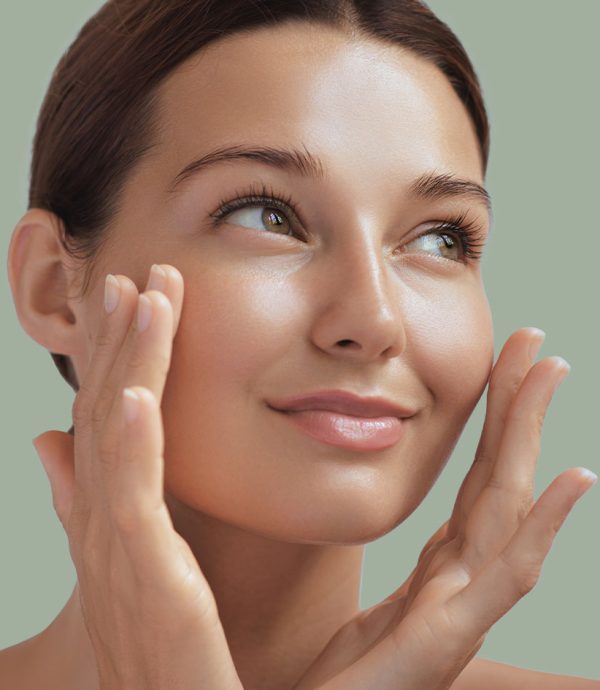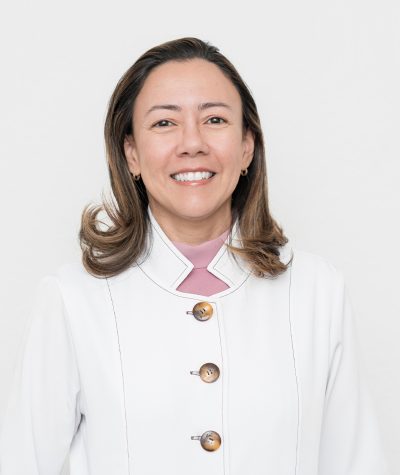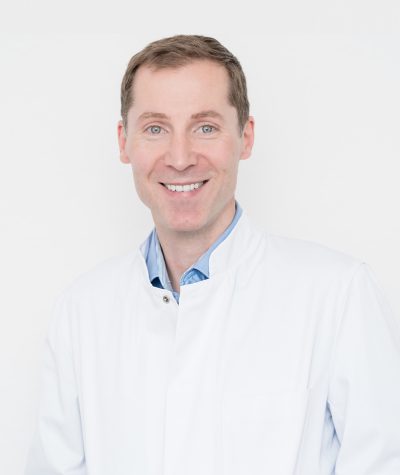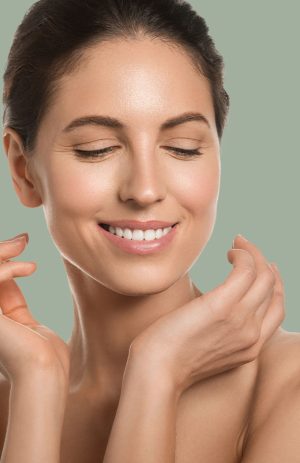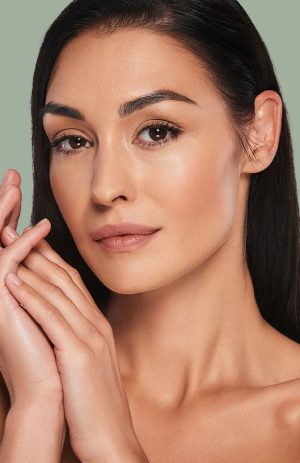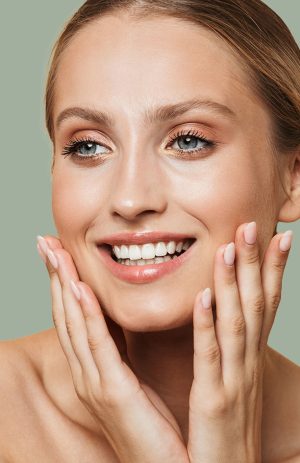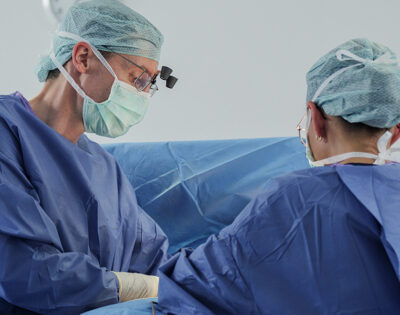Cheek correction / correction of the cheeks
High cheekbones, narrow cheeks and prominent jaw angles are a symbol of youthfulness and femininity. To emphasize the contours, make-up is used to lighten the cheekbones and blush is applied directly below the cheekbones. A congenital fat distribution disorder can lead to a round face. When fatty tissue or bone atrophy with age, contours can fade. Cheek correction can help here.
The loss of volume mainly affects the deep fat pads. The superficial fat pads, on the other hand, hardly change if the body weight remains the same. This leads to irregular transitions in the different facial regions. This creates the impression of sagging and excess skin in certain areas of the face. Knowledge of the facial anatomy and the ability to recognize which fat pads have lost volume enables targeted and effective correction of the cheeks.
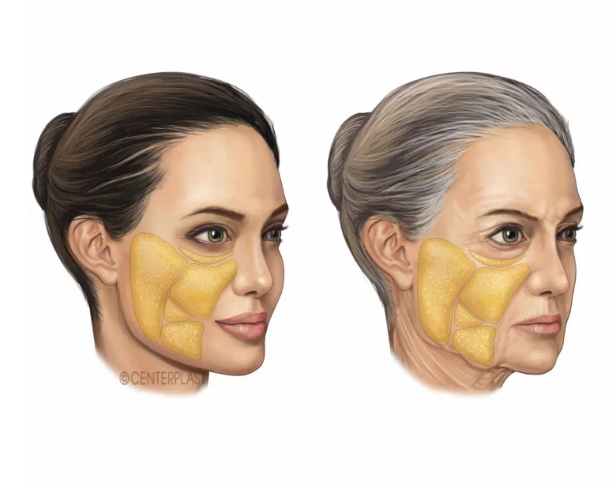
Illustration of the loss of volume of the deep fat pads with age and their irregular transitions in the different regions of the face.
Sometimes sunken cheeks are also inherited. Various methods can be used to permanently restore harmonious contours. A comprehensive examination of the face is required before every treatment. The adjacent regions in particular, such as the eyes, ears, neck and lips, should be taken into consideration when making the desired changes.
What our patients say
Applied technique for cheek contouring
Tissue injection
Tissue injections in the midface area are particularly indicated in order to:
- emphasize the contour of the cheekbones.
- soften the wrinkles in front of the ears.
- to correct sunken temples.
Injections can be carried out with nanofat or hyaluronic acid. The effect of hyaluronic acid lasts for around six to nine months. The nanofat treatment leads to a lasting result.
Remove cheek fat
Removal of the buccal fat plug (corpus adiposum buccae, also known as the “Bichat fat body”) is suitable for:
- Correction of chubby cheeks.
Liposuction of the cheeks
Liposuction of the cheeks is an effective way of
- Contouring of the cheekbones and
- Narrowing of the face.
For a well-proportioned, natural result, liposuction is usually combined with treatment of the neck and chin.
Tightening of the midface
The tightening of the midface via an approach on the lower eyelid:
- eliminates bags under the eyes and ensures
- a harmonious transition of the lower eyelid to the cheek
Lower face lift
Facelift with doubling of the deep connective tissue (SMAS) is suitable for:
- emphasize the cheekbones.
- Correct wrinkles between the lower lip and the chin (mentolabial folds, marionette lines).
- wrinkles between the wing of the nose and the corner of the mouth (nasolabial folds).
- to restore a prominent contour of the lower jaw (“jawline”).
- Eliminate sagging cheeks.
The combination of a lower face lift and a neck lift is particularly effective in improving the jaw-neck junction.
A mini face lift is particularly suitable for:
- Wrinkle correction in front of the ear.
- Emphasize the cheekbones.
A needling treatment leads to an effective:
- Correction of dark skin spots.
- Reduction of vascular drawing.
- Refinement of coarse-pored skin.
Therapy with the body’s own blood can:
- improve the skin texture.
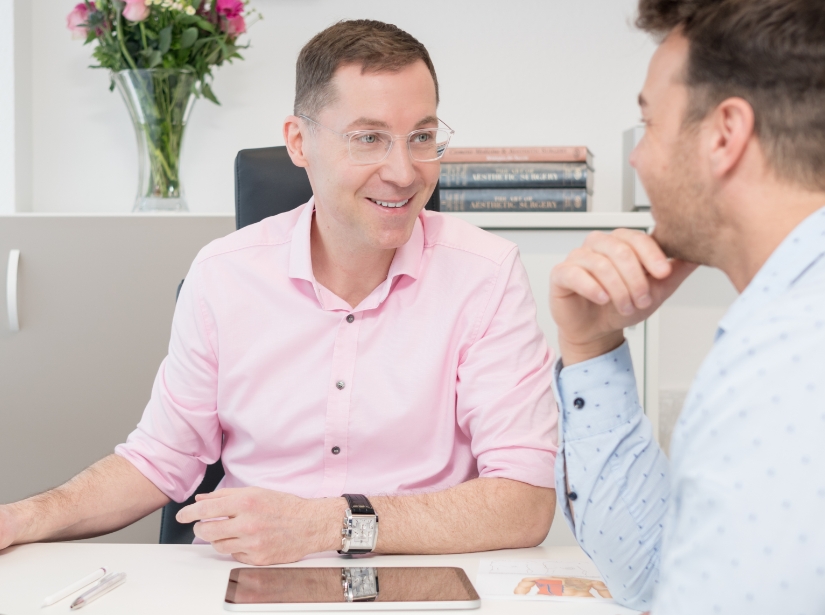
Why should you entrust yourself to an experienced specialist in plastic and aesthetic surgery?
Improving the contours of the cheeks requires more than just mastering a treatment method such as injections. The injection of fat pads has limits that are determined by the anatomy. If the skin connective tissue is sagging and there is excess skin, a facelift helps to create a harmonious and naturally rejuvenated appearance. The choice of the best individual treatment method should not be based on the doctor’s skills, but on the patient’s needs.
Although hyaluronic acid is not available on prescription, the antidote Hylase®, which should always be available in an emergency, is available on prescription.
A precise knowledge of the anatomy is important in order to recognize which fat pads have lost volume and require treatment. Disregarding natural proportions quickly leads to an unnatural result. The surgeon should therefore also be proficient in other facial surgical procedures.
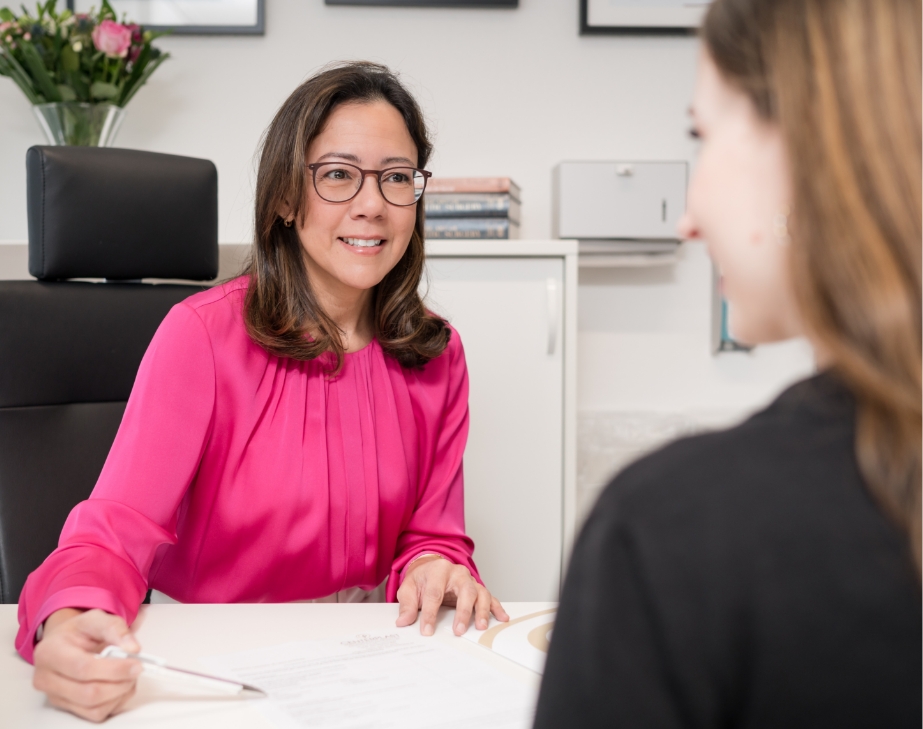
How can you prepare for a cheek correction?
- All questions about possible complications and alternative treatments should be answered before cheek correction.
- Keep nicotine and alcohol consumption to a minimum before cheek surgery.
- Taking hormone-containing medication (pill): must be temporarily discontinued.
- Blood-thinning medication such as ASA or Thomapyrin®: Discontinue at least once a month. 10 days before the cheek correction (after consultation with your doctor).
- Food supplements (omega-3 fatty acids, St. John’s wort preparations, etc.) and vitamin preparations (A, E) must be discontinued at least 4 weeks before the operation.
- Have ice cubes and/or cooling pads ready at home. These are used to cool the skin after the surgical procedure.
- Surgeries restrict the ability to travel by air. Therefore, do not plan any air travel (professional or private) in the 6 weeks following the cheek correction.
- It is recommended that you always take out follow-up cost insurance before undergoing aesthetic procedures.
How are facial surgeries performed?
Just as a pilot checks his airplane before every take-off, before every operation it is routinely checked several times whether all the necessary precautions have been taken to ensure maximum patient safety. The operation is not started until the entire checklist has been completed. This ensures that all requirements are met.
If the facial surgery is performed in twilight sleep, you will be given medication to take away your fear of the operation and reduce your sensitivity to pain. Anesthetic injections numb the surgical area within five to ten minutes. If you are not already sound asleep, you may feel something happening on the surface of your body. Minor procedures such as the removal of cheek fat, liposuction or a mini facelift can be performed under local anesthesia and twilight sleep.
The duration of the operation varies depending on the extent and scope of the procedure. Minor procedures such as cheek fat removal, liposuction or a mini facelift take 30 minutes to two hours. The incision for a facelift runs along natural dividing lines and wrinkle lines or behind the ear. A facelift takes three to five hours, depending on the technique and additional procedures. The stitches are removed after five to six days. The cheek fat plug is removed via an access at the level of the second upper molar. Self-dissolving threads are generally used here.
Immediately after the operation, you will be continuously monitored in a so-called recovery room at CenterPlast. You can drink some fluids after waking up completely. It is also possible to eat something if you already tolerate it well. Before the patient leaves the practice, follow-up appointments are arranged and behavioral measures for the aftercare period are discussed. You will receive a written report and a telephone number. In an emergency, the surgeon can be reached at this number throughout the day (24 hours).
What do you need to consider after a cheek correction?
- The recommended upper body elevation of approx. 30 degrees (including during sleep) for 5 days is beneficial for decongestion and wound healing.
- Showering is permitted (immediately before your wound check) from the 1st postoperative day.
- A previously fitted compression mask should be worn 24 hours a day for a period of one week during a facelift. After that, it is enough to wear them at night for another week.
- The skin sutures are removed approximately 5-6 days after the facial surgery.
- The scheduled lymphatic drainage from the 14th postoperative day supports the reduction of swelling.
- From the third postoperative week onwards, massaging several times a day for a few minutes will help. circular, as well as along and across the course of the scar with greasy creams (e.g. Bepanthen® Ointment or Linola® Fat) to create inconspicuous scars.
- You can go back to work after about two, better three weeks. By then the swelling and the worst of the effusions will have disappeared.
- This is followed by regular checks on your well-being and the results of the facial surgery.
- Lifting heavy loads, bending over, swimming, saunas and sporting activities should be avoided for 3 weeks. If there is still swelling, it is advisable to extend the recovery phase.
- Avoid excessive UV radiation: Solarium/sunbathing, min. for three months.


AUTHOR
Dr. Adelana Santos Stahl
Our aim is to offer optimal, discreet and precise treatment based on our extensive expertise in the field of plastic surgery.
Dr. Adelana Santos Stahl has a unique international perspective with a female view of plastic surgery. Your individual and detailed approach is the key to the beautiful and natural results. Having trained in Brazil, one of the largest and best-known countries for aesthetic and reconstructive plastic surgery, she understands her patients’ desire to look and feel their best.
She completed her medical studies and training as a specialist in plastic and aesthetic surgery in Brazil. In 2009, she also successfully passed the German equivalence examinations for the state medical examination.
Two years later, in 2011, she received the German and in 2012 the EU specialist certification (EBOPRAS) for plastic surgery. From 2009 to 2013, she deepened her knowledge of aesthetic and reconstructive facial surgery with world-renowned representatives of plastic surgery such as Professor Gubisch at the Marienhospital and Madame Firmin in Paris.
A VDÄPC Fellowship (continuing scholarship for graduate students) in Switzerland, France and the USA has further enriched her professional experience. Dr. Santos Stahl is active in various renowned professional associations. In addition to the DGPRÄC and DGBT, she is also a member of the Brazilian Society of Plastic Surgery – SBCP.
She is also the author of several scientific articles and, together with her husband, is dedicated to research and clinical studies in the field of plastic surgery.
She has been based in Saarbrücken since 2019.
You might also be interested in
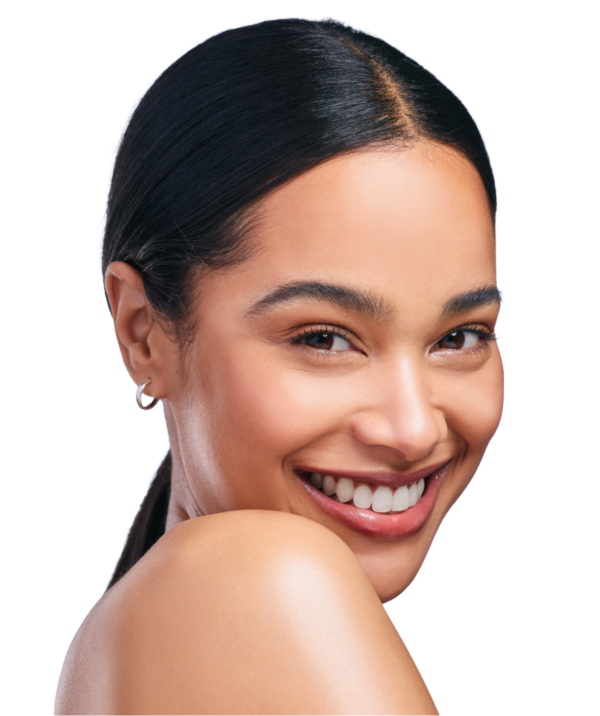
Personal advice
We take time for you and offer you customized advice and treatment for your individual result.
